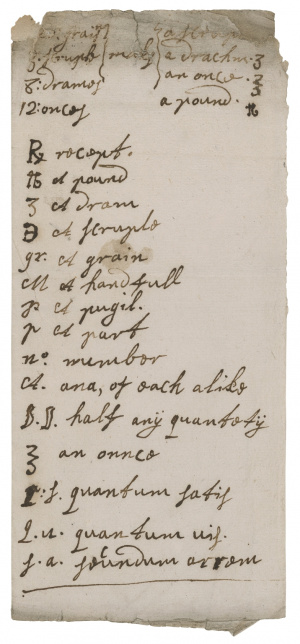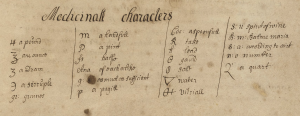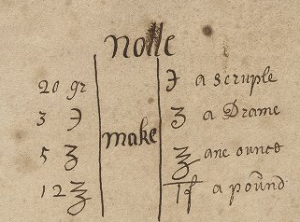Early Modern Measurements
Measurement before the enlightenment and the age of standardization varied widely. While some terms had wide adoption, others were highly regional and idiosyncratic. The following equivalencies are meant to aid in estimations.
Wet Amounts
- tun: 950-960 litres, or approximately 252 gallons during the early modern period.
 List of symbols used in recipes by Ann Goodenough (fl. 1700-1775). W.a.332.
List of symbols used in recipes by Ann Goodenough (fl. 1700-1775). W.a.332. - pipe or butt: 1/2 of a tun, 475-480 liters, or 126 gallons
- puncheon: 1/3 of a tun, 316-320 litres, or 84 gallons
- hogshead: 1/4 of a tun, 237-242 litres, or 63 gallons
- tierce: 1/6 of a tun, 158-160 litres, or 42 gallons
- barrel: 1/8 of a tun, 118-120 litres, or 31 1/2 gallons
- rundlet: 1/14 of a tun, 68-69 litres, or 18 gallons
- gallon: A measurement of capacity. The imperial gallon contains 277 1/4 cubic inches, the US gallon contain 231 cubic inches.
- quart:
- pint: 1/8 of a gallon. Pints varied by region from about half a litre to over one litre. The term comes from the Latin term pincta, for the painted marks on the side of a container to show capacity.
- The modern imperial pint is approximately 568 mL, while the US pint is1/8 of a gallon
- cup:
- ounce, fluid ounce, fl oz (℥, fl ℥, f℥, ƒ ℥): The fluid ounce was originally the volume occupied by one ounce (in weight) of some substance.
- Comparison to modern amounts: In Britain today, an imperial fluid ounce is 1/20 of an imperial pint; a US fluid ounce is 1/16 of a US fluid pint (about 4% bigger than the imperial fluid ounce). The Imperial measurements were codified in 1824.
- spoon (or spoonful): a tablespoon is, in modern measurements, about 1/2 an ounce. The term 'table spoon' comes from the transition (after 1700) from the practice of bringing a personal spoon to the table to the practice of having a place setting, or a 'table-spoon, table-fork, and table-knife'.
- dram or drachm: 1/8 of a fluid ounce, = 3 scruples
Comparisons:
1 ton = 2 butts, 3 puncheons, 4 hogsheads, 6 tierces, 8 barrels, or 14 rundlets
1 ounce = 2 table spoons, 8 drams
Dry Amounts, Money, and Weight
- Money is often used as a standardized size and weight reference, e.g. "as much of these powders as will lay on a groat".
 Margaret Baker's list of abbreviations for measurements and their definitions, from her receipt book, c. 1675. V.a.619
Margaret Baker's list of abbreviations for measurements and their definitions, from her receipt book, c. 1675. V.a.619- pound (abbreviated l or lb): the monetary unit was originally set as a pound (weight) of silver.
- shilling (abbreviated s): 1/20 of a pound, or 12 pennies (12 d = 1 s).
- groat: standardized as (theoretically) 1/8 of an ounce of silver, although there is little relation to its actual weight, given the debasement of coinage. The groat ceased circulation in 1662.
- penny (abbreviated d): 1/12 of a shilling.
- pennyworth: the amount of an ingredient that can be bought for a penny.
- obolus (abbreviated as ob): half penny.
- pounds (Troy): 12 ounces
- pounds (Apothecaries')
- pounds (Avoirdupois)
- pennyweight: a Troy unit containing 24 grains
- ounce (abbreviated oz; apothecary symbol: ℥): the apothecaries' ounce is equivalent in weight to the troy ounce
- in modern terms, 31.1g, not the ~28.3g of the avoirdupois ounce.
- scruple (℈): an Apothecaries' weight measurement, 20 grains
- grain: the smallest unit of Troy weight (24 grains to the pennyweight) and Apothecaries' weight (20 grains to a scruple)
- manipulus: a handful or bunch
- pugillus: a small handful (that which can be held in a fist, or between thumb and two fingers)
- semis: half of any quantity
- ana: of each a like amount
- bushel: a larger quantity, typically 4 pecks or 8 gallons
- lippie (lepy, leipie): dry measure used in recipes - normally a quarter of a peck or forpet

List of symbols used in recipes from page 21 of V.b.400

List of conversions between measurement amounts from V.b.400
Distance
- acre: as much as a yoke of oxen could plough in a day, later defined as an area 220 yards (40 poles) long by 22 yards (4 poles) broad
- rood: a unit of length, about 16 1/2 feet, but in later use about seven or eight yards (21 - 24 feet). Often used for land, fences, walls, etc. Can also refer to a land area equal to 40 square rods, or about a quarter of an acre.
- rod: for length, this term is equivalent to 'rood', or about 5 1/2 yards (16 1/2 feet); can also refer to a unit of land of about 30 1/4 square yards
- furlong:
- foot:
- hide: the area that could be plowed in a year by a team of eight oxen, supposedly sufficient to support a peasant family
- bovate or oxgang: 1/8 of a hide
- lug: a measure of length - pole or perch, varying according to local custom; usually of 16½ feet, sometimes of 15, 18, 20, or 21 feet